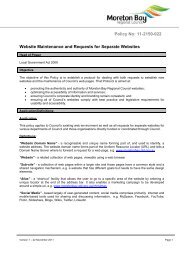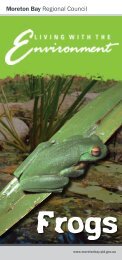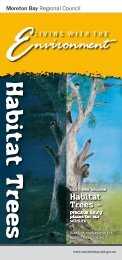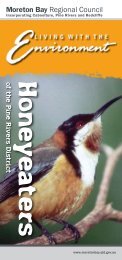South East Queensland Ecological Restoration Framework: Manual
South East Queensland Ecological Restoration Framework: Manual
South East Queensland Ecological Restoration Framework: Manual
Create successful ePaper yourself
Turn your PDF publications into a flip-book with our unique Google optimized e-Paper software.
CASE STUDY 1<br />
NUMINBAH CONSERVATION AREA (CA)<br />
ASSISTED REGENERATION<br />
- Gold coast city council<br />
BAckground<br />
The 560ha Numinbah CA ranges from degraded<br />
open areas to riparian zones (cleared and remnant),<br />
vegetated gullies, large areas of dry and wet sclerophyll<br />
vegetation types as well as dry and sub-tropical<br />
rainforest. The site varies in its level of degradation<br />
from open pasture to native vegetation that is a<br />
mixture of regrowth and remnant. The resilience of the<br />
site is estimated to be high due to existing vegetation,<br />
diversity of flora and fauna and where the site sits in<br />
the landscape. There are however large open areas<br />
including a section of creek that will require planting<br />
due to previous disturbance, a lack of forest structure<br />
in some areas and the lack of an intact soil profile in<br />
other areas.<br />
After a desktop analysis where Regional Ecosystem<br />
mapping, flora and fauna records and fire mapping<br />
were interrogated, a number of site visits were<br />
conducted and a restoration plan was developed. The<br />
site was divided into precincts, zones and sub-zones<br />
to assist workers and managers with the direction of<br />
works. Once primary and follow-up works stabilise<br />
in one zone, works continue into the next zone after<br />
ensuring previous works are consolidated. Due to<br />
the size of the site coupled with competing priorities,<br />
works have simultaneously commenced in four<br />
different precincts designed to join up significant<br />
areas in the most ecologically and cost effective way<br />
possible while ensuring workers are provided with<br />
psychological boosts by seeing whole areas complete.<br />
Most of the site will be restored via the ‘assisted<br />
regeneration’ approach where key areas are<br />
encouraged to regenerate with native species from<br />
the seedbank or surrounding biomass. Weeds are<br />
controlled in such a way that soil, habitat and water<br />
quality is protected and methods used continue to<br />
encourage the succession of native species. One<br />
section of creek will be planted in the next couple<br />
of years to assist with stabilisation, water quality and<br />
connectivity to other forested areas. The remaining<br />
open areas will be encouraged to reduce over time<br />
(maximising resilience while minimising costs) and any<br />
large gaps still remaining by year 8-10 of the project<br />
may be planted using locally collected seed.<br />
IMPLEMENTATION<br />
Primary works involved cutting and painting lantana<br />
(Lantana camara) from around natives (starting in<br />
zone 1) and to assist with creating access, as well as<br />
other primary weed control such as cutting glycine<br />
(Neonotonia wightii) and other exotic vines off native<br />
plants, spray preparation (hand weeding around<br />
seedlings or on immediate toe of bank) or isolating<br />
lantana for subsequent over-spraying activities.<br />
Secondary works included spot-spraying ground<br />
weeds such as mistflower (Ageratina riparia), broadleaved<br />
paspalum (Paspalum mandiocanum), blue billygoat<br />
weed (Ageratum houstonianum), crofton weed<br />
(Ageratina adenophora) and re-shooting lantana as<br />
well as over-spraying dense lantana. Maintenance has<br />
consisted of ensuring exotic and vigorous native vines<br />
do not take advantage of the trellis of dead lantana,<br />
following up on weed growth while ensuring the<br />
timing of maintenance activities is not left too long nor<br />
carried out so frequently that further ground is hard to<br />
gain. Monitoring the success of the zone is essential<br />
to expanding works. The weed control techniques<br />
included:<br />
• Cut-Scrape-Paint (CSP) – used in the control of<br />
lantana when it is mixed with native vegetation.<br />
Loppers were used for accuracy, durability<br />
and safety and the plant is chopped up into<br />
approximately 50cm pieces and left on the ground<br />
to break down over time. The base is then treated<br />
and painted with glyphosate at a rate of 1:1<br />
glyphosate:water. This is also used for exotic vines<br />
such as glycine. Anything above the head is left to<br />
breakdown and fall over time i.e. pulling it from the<br />
mid-storey or canopy will damage the native host.<br />
• Spot-spraying – used for controlling ground<br />
weeds and weeds that have re-shot. Care was<br />
taken to prepare sensitive areas by hand-pulling or<br />
pushing down weeds from around native seedlings<br />
and ferns. An adjustable nozzle that allows the<br />
practitioner to delicately spot-spray weeds<br />
amongst native plants is required. This technique is<br />
also the most efficient way to maintain whole areas<br />
which is a necessary part of the restoration process<br />
especially on a large site like this.<br />
• Over-spraying – used for over-spraying large<br />
sections of lantana that had been previously<br />
prepared by cutting it away from natives and<br />
creating tracks so all clumps could be reached and<br />
maintained.<br />
SEQ <strong>Restoration</strong> <strong>Framework</strong><br />
72<br />
MANUAL


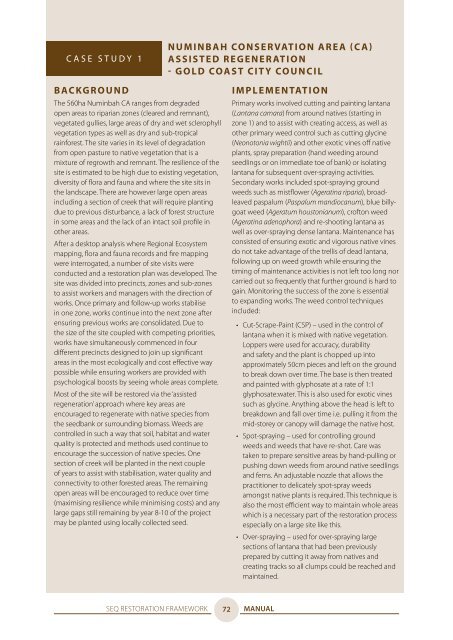
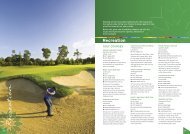

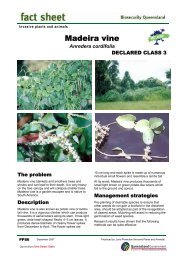
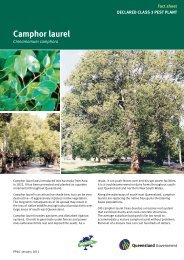


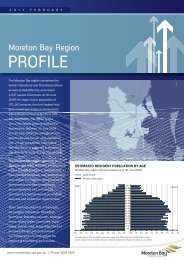
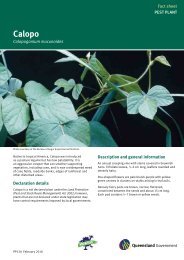

![Kumbartcho Brochure [PDF 540KB] - Moreton Bay Regional Council](https://img.yumpu.com/47220970/1/190x101/kumbartcho-brochure-pdf-540kb-moreton-bay-regional-council.jpg?quality=85)
